
Oswald Dennis’ work is usually characterised by intricate topographical images that discourse the impact of colonialism on the African continent. In the ‘Options’ exhibition the artist showed that he is concerned with the impact of colonialism on the existential and ontological space. Intricate works or drawings also characterise this show, but their relationship with text is characterised by words that denote prepositions, text that articulate a sense of relevance in the protracted post-colonial present.
(text on home page)
Themba Tsotsi on the work of the South African artist Nolan Oswald Dennis
Options, 2018
Nolan Oswald Dennis’s historic ‘Options’
This article will examine the works in his latest exhibition with the Goodman Gallery titled ‘’Options’’, highlighting the motif of disentangled protraction in the forms of the works, stating that they are symbolic of the limitations of post-colonial discourse on the collective psyche of previously colonized peoples. By explaining the significance of the receipt printer installations mounted on the wall, it will demonstrate that they are symbolic of the impact of colonialism on writers and writing as a social element.
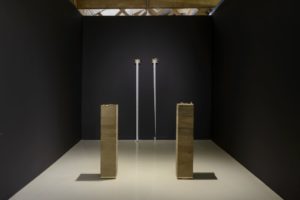
Options, installation view, 2019
By also discussing the measure the operation of linguistic forms takes in the exhibitions. It will show that the prepositions that are used entail the expression of temporal relations in the social context. In this way they enable social contexts to operate with the disentangled protraction that the artist designates as ‘’the longness of now’’, contexts that are the recycled moments of history.
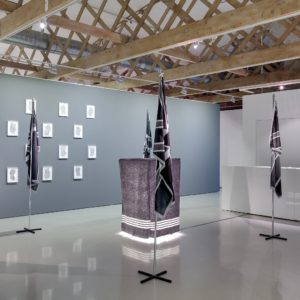
Furthermore, 2017
Oswald Dennis’s previous exhibition with Goodman Cape Town titled ‘’Furthermore’’ is related to ‘’Options’’. By comparing the ‘’Furthermore’’ exhibition to ‘’Options’’ I would like to state that ‘’Furthermore’’ examined the historic fictional grandeur of historic moments, and that ‘’Options’’ examines the use with which language renders contexts protracted and susceptible to repetition.
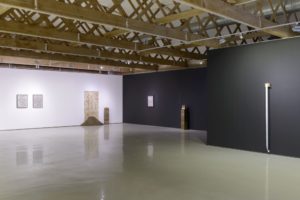
Options, installation view, 2019
Oswald Dennis’ work is usually characterised by intricate topographical images that discourse the impact of colonialism on the African continent. In the ‘Options’ exhibition the artist showed that he is concerned with the impact of colonialism on the existential and ontological space. Intricate works or drawings also characterise this show, but their relationship with text is characterised by words that denote prepositions, text that articulate a sense of relevance in the protracted post-colonial present.
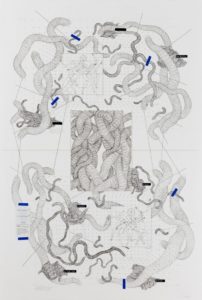
Afterworld, 2018
The drawings in the show are characterised by entangled and intricate images that resemble haphazard ropes that are symbolic of topographical images. With the small words or text within the images, the artist represents a measure of disentanglement, in that it is text that can recycle the measure of subjective language in the contemporary context to attempt to disentangle the confusion in the present. Text becomes a starting point; it also becomes the ambiguous facility for individual emancipation or self-oppression.
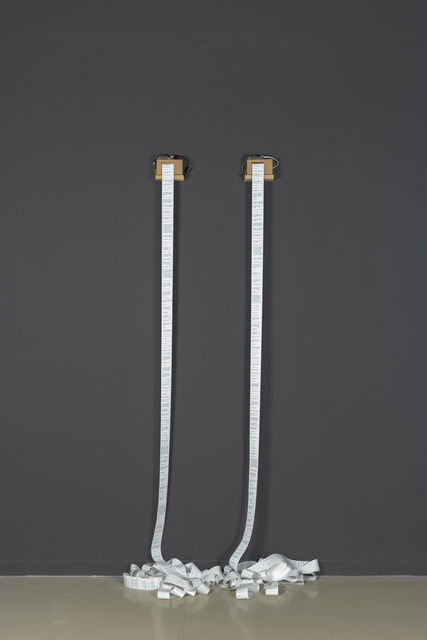
Biko/Fanon, 2018
The exhibition is characterised by works that can be described as protracted, some characterised by a repeated text. In this way not only can historic beginnings be discerned for their measure to be continuations of contexts before their canonisation, they also characterise future beginnings. This is mostly expressed in the two receipt instillations titled ‘’Biko/Fanon’’ and ‘’Nomzamo’’.
The “Biko/Fanon’’ piece is comprised of texts from the seminal works of the two writers, repeated in the prints of the printers mounted on the gallery wall. Dennis demonstrates that repetition is history’s foundation as a didactic facility but it is also the means with which ‘’social fictions’’ emerge. The use of the two significant writers in post-colonial discourse is also indicative of the ‘many worlds’ that exist. These writers explicated the ambiguity of freedom in a context and history characterised by oppression.

Nomzamo, 2018
The “Nomzamo” printer is characterised by a more existential text, articulating the role of personal choice in relation to historical choices. Writing and everyday life are juxtaposed to express the symbiotic measure with which previously colonised peoples are perpetually in a temporal transitory condition. What is poetic about the image of the printer is that it subsumes a measure of systematic choreography, but it is also characterised by a necessary implication towards what is systematic. In this way the artist is able to demonstrate how it is limited in its structure and impersonal in how it is implemented. In this way writing and writing with a socially creative element can be demonstrated to form part of its manifestation. In this way the artist demonstrates that writing is not just a repetition of political systems; rather writing expresses its ontological results.
*
In the exhibition he previously held with the Goodman Gallery in 2016 titled ‘’Furthermore’’, there was the use of political signs and mechanisms to demonstrate this temporal transitory condition as historic memory. In that exhibition what was emphasized was how static this condition is in the context of political power and structures. There were light installations scattered around the exhibition space with a blanket over the light. One was surrounded by a black and white British colonial flag and a black and white South African flag, a piece that was choreographed in the ritualistic and austere manner reminiscent of political processions. Behind the installation’s ink drawings of the South African flag, the covered light is not only symbolic of extent to which state structure and its paraphernalia perpetuate a mysterious distance between itself and the community, but it is also symbolic of a lack of articulation on the part of the structure. The lack of colour on the flags communicated a lack of vitality on the part of state structures in articulating a measure of entangled value and morality. In an online article from 2016 for the Mail and Guardia nit is written: ‘’this captivating body of work by Dennis, born of South African parents in the late 80’ ,examines the notion of repeating histories – the replaying of the past despite renewed political promises.’’ https://mg.co.za/article/2016-05-12-shattered-dreams-and-the-future
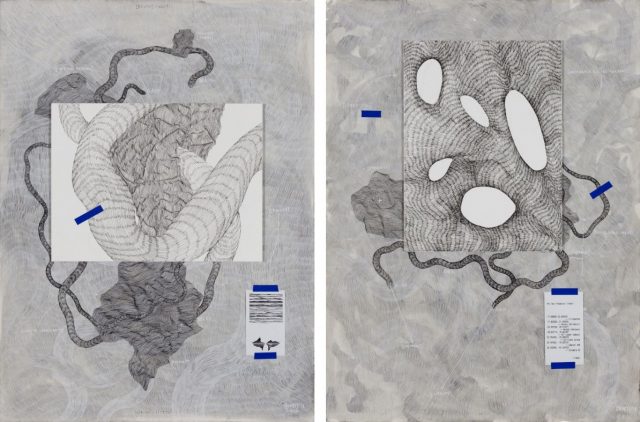
The Last Rhodesian (interspace south), The Last Rhodesian (interspace north), 2018
‘’The last Rhodesian (interspace north)” is another piece in which what is entangled can be discerned. ‘’The last Rhodesian’’ is a piece within a piece. It expresses how the internal existential space is also symbolic of terrain, but in order to be characterised like this the existential space has to have a relationship with physical terrain. It can be discerned in the superimposed strategy with one piece layered on another, the work is finished with. This entangle rope image is superimposed with another one rendered in black marker. The title of the piece expresses how historic terrains have become etched in the existential terrain. How this relationship is recycled in a temporal sense the artist demonstrated, forms part of the personal experiences and choices in the use of language. The artist also shows they are symbolic of the role prepositions and their transitory connotations play in everyday language. Just like in ‘’Furthermore’’ the existential is deemed to be crucial to the symbolic role of political signs, but in ‘’Options’’ language is more significant, articulating how words denoting subjection transform to words denoting objective transformation. This way their ambiguity can be discerned for both the coloniser and the previously colonised.

Xenolith IV, 2018
The piece titled ‘’Xenolith IV’’ is another piece which is symbolic of the motif of recycled repetition in the exhibition. An adapted globe is mounted on a pillar. The globe resembling a basketball also continues the measure and image of repetition in the colonial and post-colonial terrain being made up of the same structure and the contemporary influences. The piece articulates more than just the operation of repetition that characterises history; it is also the measure in the contemporary that expresses the force of what is past, where it operates beyond language and the written form. The image of the globe is one of violence and power, colonisation of not just physical terrain, but also colonisation of future forms of articulating and expressing how individuality is emancipated in the post-colonial context. The measure of minimalism in Oswald Dennis’s installations articulate this sense of inherited beginnings or beginnings that express inherited forms of expression. ‘Xenolith’s’ ambiguity is about literal and superficial ways of expressing collective experiences both in an historic and contemporary measure for both the previously colonised and the coloniser. It articulates what cannot be pinned down about history, that the measure in history that is perpetual can be characterised as monochromatic. Oswald Dennis is not stating that history is protected by an unclear veil. Rather history’s past entanglements keep rising, repeating not just their original impact, they also influence contemporary entanglements.
The title of the exhibition is rooted in the contemporary experience. This not only expresses the ambiguous space that individuality occupies, it also characterises his or her relationship to power in an ambivalent measure. This way the artist shows one is constantly stuck in the entanglements of history. Bound by the logic of the impersonal but multicultural contexts. ‘’Options’’ expresses a personal challenge to his audience. He understands where choice and power can influence and inform social navigation.
BIO
Nolan Oswald Dennis is a South African artist based in Johannesburg. Dennis’s work examines the impact of colonialism in the esoteric language of political systems that govern society. In 2016 he won the FNB Art Prize placing him in a list of prestigious artists who have won the prize since its inception in 2011. Oswald Dennis is also a lecturer, in 2016 his degree partly comprising architecture, he taught architecture at the University of Witswatersrand. He has presented paper at the British Columbia University and the University of Rochester. He also has been published in numerous publications like the University of Rochester Journal of Visual Culture and a published paper at the Centre de Laboratoires Associes’ pour la Rocherche and Architecture No. 4. On the Art Africa Magazine site it is written in the following manner about the prize. ‘’The FNB Art Prize has become one of the converted visual art prizes on the African continent. Aside from the dedicated space, the winning artist will also receive a cash prize, and will no doubt benefit heavily from the subsequent media interest and coverage of the fair, helping to catapult the artist and his work to the centre of contemporary art discourse.’’
Oswald Dennis has held residencies at the Meetfactory Residency, Prague, in 2017, the Atelier Mondial in Basel in 2016 and the Berlin Biennale with (NTU) in 2016 to name a just a few.
Nolan Oswald Dennis / Options / 2019, 24 JANUARY – 09 MARCH 2019, Goodman Gallery Cape Town
Themba Tsoti is a freelance writer writing mainly about visual art, based in Cape Town. He graduated from University of the Western Cape B.A Honours in English and Cultural Studies in 2006. He was founding member of Gugulective and has recently published his first book titled “Art Movements and The Discourse of Acknowledgements and Distinctions” (Vernon Press).
